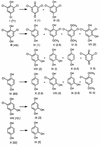Degradation of 2,4,6-trichlorophenol by Phanerochaete chrysosporium: involvement of reductive dechlorination
- PMID: 9748450
- PMCID: PMC107553
- DOI: 10.1128/JB.180.19.5159-5164.1998
Degradation of 2,4,6-trichlorophenol by Phanerochaete chrysosporium: involvement of reductive dechlorination
Abstract
Under secondary metabolic conditions, the lignin-degrading basidiomycete Phanerochaete chrysosporium mineralizes 2,4, 6-trichlorophenol. The pathway for the degradation of 2,4, 6-trichlorophenol has been elucidated by the characterization of fungal metabolites and oxidation products generated by purified lignin peroxidase (LiP) and manganese peroxidase (MnP). The multistep pathway is initiated by a LiP- or MnP-catalyzed oxidative dechlorination reaction to produce 2,6-dichloro-1,4-benzoquinone. The quinone is reduced to 2,6-dichloro-1,4-dihydroxybenzene, which is reductively dechlorinated to yield 2-chloro-1,4-dihydroxybenzene. The latter is degraded further by one of two parallel pathways: it either undergoes further reductive dechlorination to yield 1, 4-hydroquinone, which is ortho-hydroxylated to produce 1,2, 4-trihydroxybenzene, or is hydroxylated to yield 5-chloro-1,2, 4-trihydroxybenzene, which is reductively dechlorinated to produce the common key metabolite 1,2,4-trihydroxybenzene. Presumably, the latter is ring cleaved with subsequent degradation to CO2. In this pathway, the chlorine at C-4 is oxidatively dechlorinated, whereas the other chlorines are removed by a reductive process in which chlorine is replaced by hydrogen. Apparently, all three chlorine atoms are removed prior to ring cleavage. To our knowledge, this is the first reported example of aromatic reductive dechlorination by a eukaryote.
Figures




References
-
- Bumpus J A, Aust S D. Biodegradation of environmental pollutants by the white rot fungus Phanerochaete chrysosporium: involvement of the lignin-degrading system. Bioessays. 1987;6:166–170.
Publication types
MeSH terms
Substances
LinkOut - more resources
Full Text Sources
Other Literature Sources
Miscellaneous

